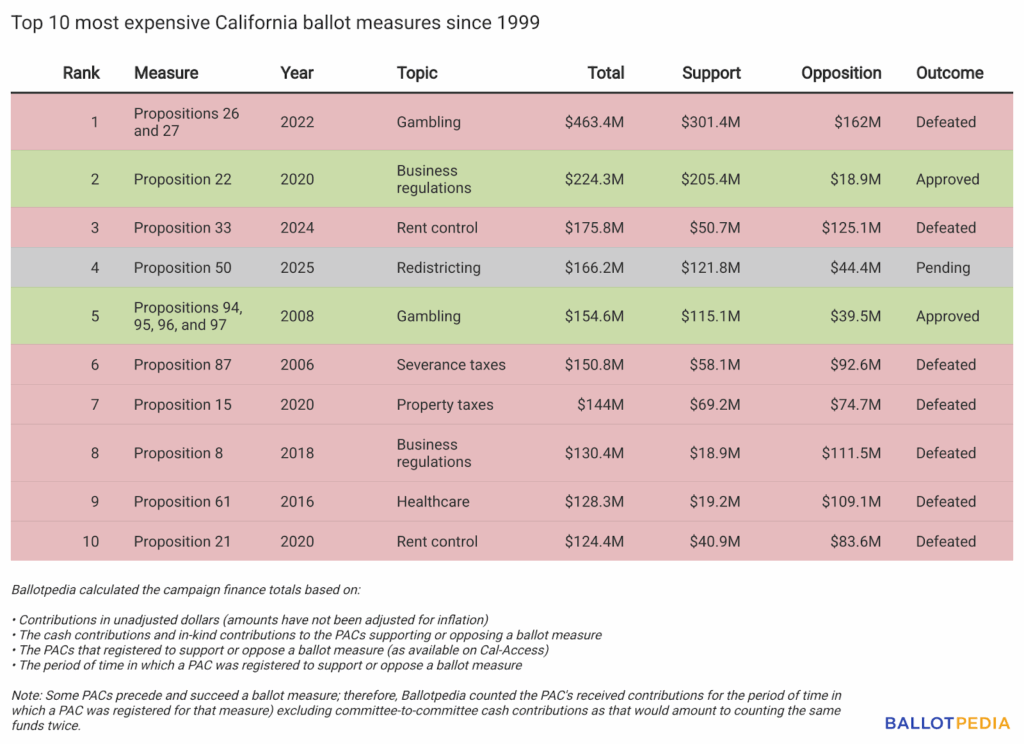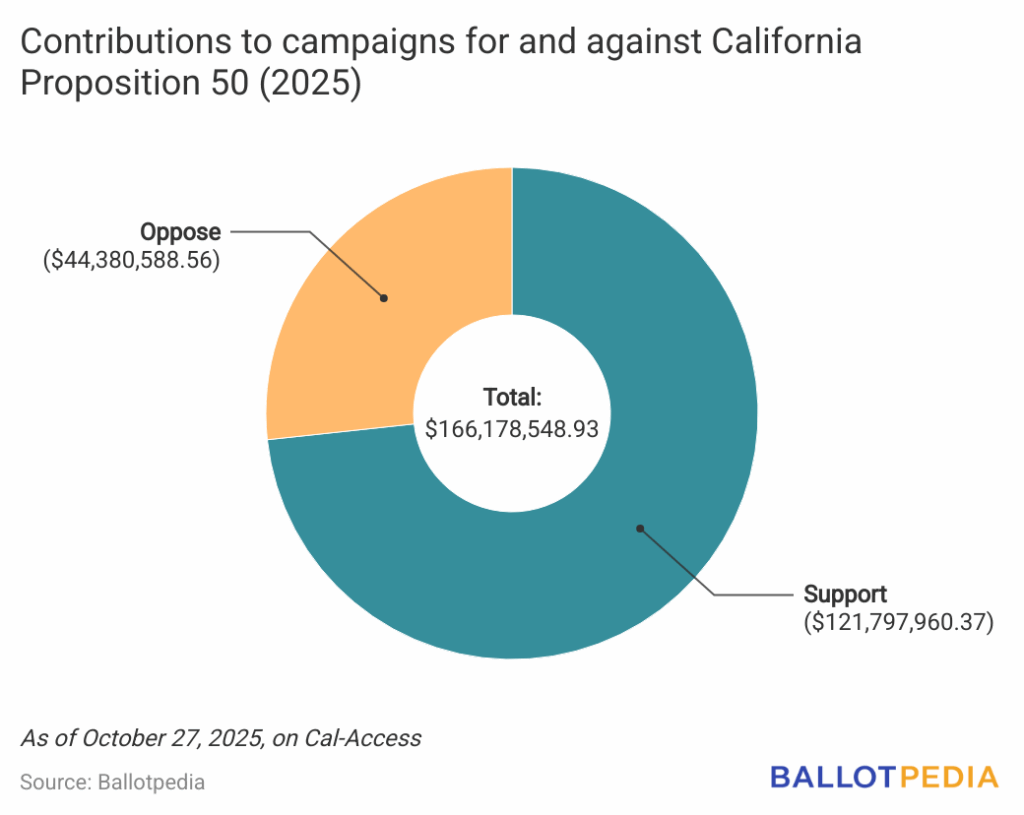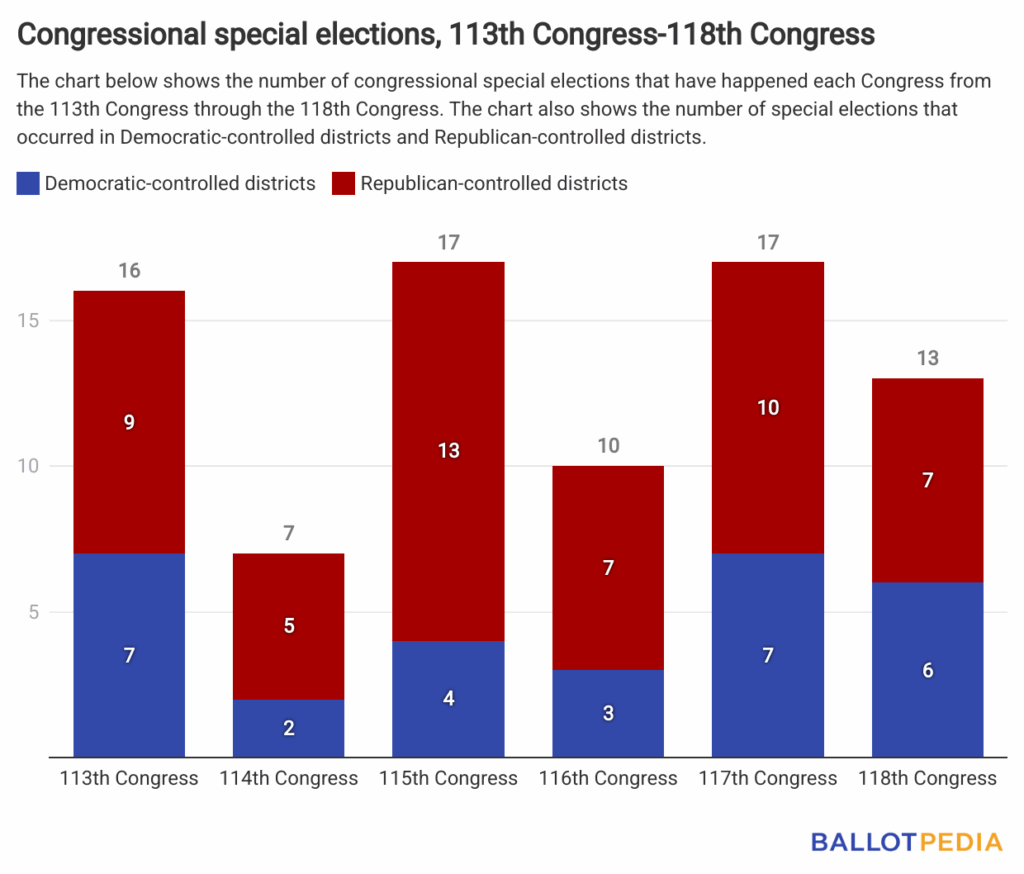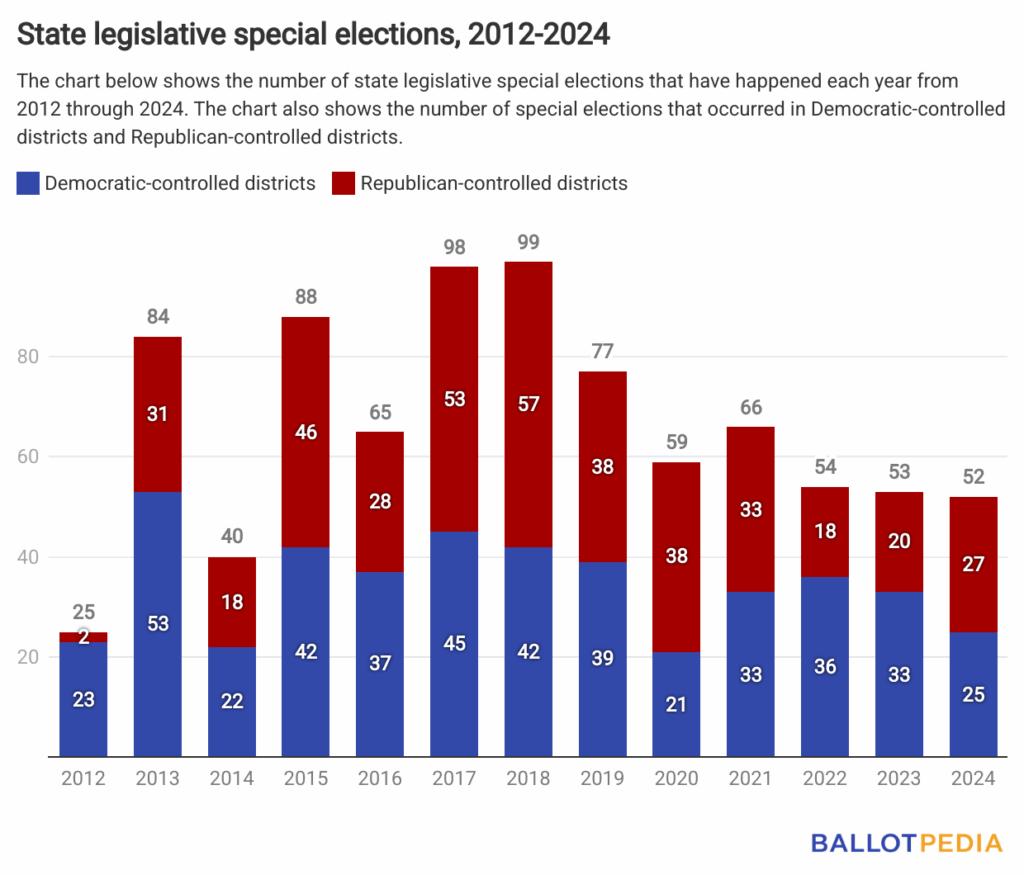Welcome to the Thursday, Oct. 30, 2025, Brew.
By: Lara Bonatesta
Here’s what’s in store for you as you start your day:
- Voters in California, Maine, and Texas to decide ballot measures on elections and voting policy on Nov. 4
- California Proposition 50 becomes the fourth most expensive ballot measure in state history, with $166.2 million between supporters and opponents
- A look at the congressional and state legislative special elections happening on Nov. 4
Voters in California, Maine, and Texas to decide ballot measures on elections and voting policy on Nov. 4
Ballotpedia will cover 24 statewide and 188 local ballot measures on Nov. 4. While they address lots of topics, one key theme is election policy.
Voters in California, Maine, and Texas will decide on statewide ballot measures related to elections. Voters in several cities, including New York City, will also decide on election policy measures.
California Proposition 50
The most notable of these measures is California Proposition 50, which would authorize the state to use a new, Legislature-drawn congressional district map for the 2026 through 2030 congressional elections. Under Prop. 50, five currently Republican-held districts would shift to become more Democratic, based on the 2024 presidential election results. The Citizens Redistricting Commission would redraw congressional districts in 2031, following the 2030 U.S. census.
Prop. 50 recently became the fourth-most expensive ballot measure in the state’s history. For a more complete rundown on that, see our next story below.

Texas Proposition 16
Texas voters will decide on Proposition 16, a constitutional amendment that says "persons who are not citizens of the United States" cannot vote in elections in Texas. Current state law requires that residents must attest to being a citizen when registering to vote. Because Proposition 16 is an amendment, any future changes would require an additional constitutional amendment.
Federal law prohibits noncitizens from voting in federal elections. Washington, D.C., and municipalities in three states—California, Maryland, and Vermont—allow noncitizens to vote in at least some local elections. No state constitutions explicitly allow noncitizens to vote in state or local elections, and 17 states explicitly prohibit it. From 2018 to 2024, voters approved 14 ballot measures that added language about citizenship requirements for voting. In Texas, only the Legislature can put constitutional amendments on the ballot. Of the 14 amendments voters approved between 2018 and 2024, 11 were legislative referrals and three were citizen initiatives.
Maine Question 1
Maine voters will be deciding Question 1, which would require voters to present photo identification for both in-person and absentee voting, and would also change the rules for absentee voting and election ballot drop boxes.
Some of the changes to absentee voting would include:
- Requiring voters to complete an identification envelope with their identification number, name, birth date, address, and the election type and date
- Allowing election officials or registered voters in the same jurisdiction to challenge absentee ballots for reasons including mismatched signatures and a failure to provide an ID number
- Prohibiting prepaid postage on return absentee ballot envelopes
- Repealing provisions allowing disabled and senior voters (65 and older) to receive absentee ballots for each election without submitting a new request
- Limiting each local government to one ballot drop box
Between 2004 and 2024, voters in nine states decided on 10 ballot measures related to voter ID, with eight (80%) being approved. Maine Question 1 is unique among these other measures because it makes changes to absentee voting and ballot drop box rules in addition to requiring voter ID. The support campaign is called Voter ID for ME, while the opposition campaign is called Save Maine Absentee Voting.
Currently, 36 states require voters to present identification in order to vote at the polls on Election Day. States differ in how they apply voter identification laws for absentee/mail-in voting. Click here to learn more.
Local election-related ballot measures
Voters will also decide local ballot measures related to elections in New York City, Greenbelt, Maryland, and Virginia Beach, Virginia.
In New York City, Question 6 would move the city’s primary and general elections from odd-numbered years to even-numbered years, to coincide with federal presidential elections. This would affect the elections for mayor, comptroller, public advocate, city council members, and borough presidents. However, the change could not take effect unless the Legislature also amends Section 8 of Article XIII of the New York Constitution, and voters approve that amendment.
Six of the top 25 most populous U.S. cities—Los Angeles, Phoenix, San Diego, Austin, San Francisco, Washington, D.C.—hold elections in even-numbered years. The remaining 17 cities in the top 25 hold elections in odd years.
In Greenbelt, Maryland, voters will decide on an advisory question regarding ranked-choice voting for city council members. A yes vote would support advising the city government to adopt ranked-choice voting and change the threshold required to be elected. The advisory question is non-binding. If it passes, the Greenbelt City Council would have to pass this change. Ranked-choice voting (RCV) is an electoral system in which voters rank candidates by preference on their ballots. Currently, three states use RCV statewide. Alaska and Maine use it in some federal and statewide elections, while Hawaii uses it for certain statewide elections. Fourteen states contain localities that use RCV in municipal elections, and seventeen states have adopted laws prohibiting the use of RCV in any elections.
Virginia Beach voters will decide on a measure that would ask the General Assembly to amend the city charter to change how the city council and mayor are elected. The amendment would create 10 single-member districts where voters elect one member from their respective districts and provide that the mayor would be elected at-large. This system is called the 10-1 system. The current city charter provides for a 7-3-1 system, which was modified in 2021, in which seven council members are elected in districts and three are elected at large.
Click on the following links to learn more about this year’s statewide and local ballot measures.
California Proposition 50 becomes the fourth most expensive ballot measure in state history, with $166.2 million between supporters and opponents
California Proposition 50 is now the fourth most expensive ballot measure in the state’s history. Voters will decide the measure, which would authorize a new congressional district map, at a special election on Nov. 4.
Gov. Gavin Newsom (D) said that the ballot measure is intended to counter a mid-cycle redistricting proposal in Texas, which would, according to The Texas Tribune, “[position] the GOP to net up to five additional seats in Texas." For additional coverage on redistricting efforts that were approved, are underway, or have been proposed in other states, click here.
As of Oct. 27, committees supporting and opposing the measure had raised a combined $166.2 million. Supporters reported $121.8 million, while opponents reported $44.4 million.
Comparison to other most expensive measures in California
Proposition 50 is different from the other ballot measures on the top-10 list in at least two ways: its subject—redistricting—and its donor composition.
Other measures on the list addressed issues such as gambling, taxation, and business regulation. With those ballot measures, the largest share of funding on at least one side came from entities with some financial interest in the outcome of the election. With Proposition 50, the largest donors on both sides include individuals, political committees, and nonprofits, with labor unions also accounting for large donations on the support side.
The following table shows the top 10 most expensive ballot measures in California history. Click here for more information.

Of the 10 most expensive ballot measures, the side with the most contributions won in every election except the costliest, Propositions 26 and 27 (2022), which had $463.3 million in contributions. Both ballot initiatives sought to legalize sports betting under different systems and had overlapping campaigns that spent against each other. Voters rejected both.
Support for Prop. 50
Yes on 50, also known as The Election Rigging Response Act, Governor Newsom’s Ballot Measure Committee is leading the campaign in support of Proposition 50. Twelve additional state-level political action committees (PACs) registered and reported contributions in support of the ballot measure.
As of Oct. 27, supporters raised $121.8 million and spent $84.7 million.
The largest donors to the support PACs were:
- The House Majority PAC (HMP), along with the associated HMP for Prop 50 PAC, contributed $16.4 million—13.5% of the campaign's total funds. HMP is a super PAC that focuses on electing Democrats to the U.S. House of Representatives
- The Fund for Policy Reform contributed $10 million. FPR is a 501(c)(4) associated with the Open Society Foundations, founded by George Soros. According to FPR's Form 990, the organization's mission is to support legislation that "assures greater fairness in political, legal and economic systems and safeguards fundamental rights."
- The California Teachers Association Issues PAC contributed $3.9 million.
- The California Nurses Association contributed $3.4 million.
- The National Education Association contributed $3 million.
Tom Steyer also made an independent expenditure of $12.8 million for advertisements supporting Proposition 50. Steyer is an investor, philanthropist, and donor to progressive and Democratic causes. He founded the organization NextGen America and ran for president in 2020. Steyer made the expenditure separate from the PACs supporting Proposition 50.
Based on campaign finance reporting through Oct. 18, the support PACs reported 108,359 unique donors, including 55,441 (51.2%) who are California residents. The average donation size was $951, and the median donation was $100.
Opposition to Prop. 50
Two PACs—No on Prop 50 - Protect Voters First and No on Prop 50 - Stop Sacramento's Power Grab—are leading the campaigns opposing Proposition 50. Five additional state-level PACs registered and reported contributions in opposition to the ballot measure.
As of Oct. 27, opponents raised $44.4 million and spent $41.9 million.
The largest donors to the opposition PACs were:
- Charles T. Munger, Jr. contributed $32.7 million—73.9% of the opposition's total funds. Munger, a physicist and political donor, is the son of Charles Munger Sr., who was a business partner at Berkshire Hathaway. He chaired the Santa Clara County Republican Party (2012-2015) and the California Republican Party's Initiatives Committee (2013-2019). He contributed to several ballot measure campaigns in the 2000s and 2010s, including campaigns to create the California Citizens Redistricting Commission.
- The Congressional Leadership Fund contributed $5 million. The Congressional Leadership Fund is a super PAC that focuses on electing Republicans to the U.S. House of Representatives.
- The Kevin McCarthy for Congress PAC contributed $1 million. McCarthy served in the U.S. House of Representatives from 2007 to 2023, including as Speaker from Jan. to Oct. 2023
- Thomas M. Siebel, Chairman of C3.ai, Inc., contributed $1 million.
Based on campaign finance reporting through Oct. 18, the opposition PACs reported 419 unique donors, including 391 (93.3%) who are California residents. The average donation size was $104,512, and the median donation was $250.
The final campaign finance filing deadline before the election was Oct. 23. The next deadline is on Feb. 2, 2026. Campaigns must report contributions exceeding $1,000 within 24 hours during the 90 days preceding the election.

Click here to see more of our coverage of Proposition 50.
A look at the congressional and state legislative special elections happening on Nov. 4
There is less than a week to go until Election Day, and Ballotpedia will cover more than 10,000 elections on Nov. 4. To help our readers understand what’s at stake, the Daily Brew will feature previews of key elections from now through Election Day. To see what elections we're covering in your area, check out our Sample Ballot Lookup Tool.
Ballotpedia is covering contested special elections for one congressional district and 23 state legislative districts on Nov. 4.
Click below to see our previews on:
- Mayoral elections
- Local battlegrounds
- Statewide ballot measures
- Local ballot measures
- Gubernatorial elections
Congressional special election
Amanda Edwards (D), Jolanda Jones (D), Christian Menefee (D), Carmen Montiel (R), and 12 other candidates are running in a special election to succeed former Rep. Sylvester Turner (D-Texas) in Texas' 18th Congressional District. Candidates from all parties are running in the election, and if no one wins an outright majority, the top two candidates will advance to a runoff. The date of the possible runoff has not yet been announced. The winner of this election will be the fourth person to represent the district since 2024.
This special election could have implications on legislative votes in the House. As of Oct. 29, Republicans have a 219-213 majority in the U.S. House, with three vacancies. If a Republican wins, Republicans will still have enough votes to pass legislation, even if three Republicans vote with Democrats or don’t vote. If a Democrat wins, Republicans will only still have a majority if two or fewer Republicans vote with Democrats or don’t vote.
The Leader's Betsy Denson wrote that aside from completing the remainder of Turner's term, the election "could also set the tone for the district's future as it navigates shifting boundaries, evolving demographics, and pressing local and national issues." On Aug. 29, Texas Gov. Greg Abbott (R) approved a new congressional map that changes the boundaries of the 18th Congressional District. The special election will take place within the boundaries of the old district. The first election to occur using the new district boundaries will be the March 2026 primary.
As of Oct. 27, there have been four special congressional elections for the 119th Congress. Two were in Democratic-controlled districts, while two were to fill Republican controlled-districts. None of those elections resulted in a change in partisan control.

State legislative special elections
At the state level, 23 contested special legislative elections are taking place nationwide. Three other state legislative special elections are also taking place on Nov. 4, in which candidates are running unopposed. Additionally, seven other state legislative special elections scheduled for Nov. 4 were canceled because the candidates were running unopposed.
In the 23 districts with contested elections, 14 were previously held by Democrats and nine were held by Republicans. Eight are in a state's lower chamber and 15 are in a state's upper chamber.
Two elections in Minnesota Senate Districts 29 and 47 will determine partisan control of the chamber. Currently, Democrats have a 33-32 majority in the Minnesota Senate with two vacancies. This means the races are a chance for Democrats to widen their majority in the chamber, and a chance for Republicans to win a majority for the first time since 2022.
Ten of the special elections are happening in Mississippi. While three of those special elections are to fill vacancies in the Mississippi Legislature, a federal three-judge panel ordered the other seven to happen. In July 2024, the panel ruled that Mississippi's legislative map violated section 2 of the Voting Rights Act. As a result, the state needed to enact new maps and set special election dates.
As of Oct. 28, 49 state legislative special elections have occurred. Twenty-five of those elections were in Democratic-controlled districts, while 24 were in Republican-controlled districts. Four of those elections resulted in changes in partisan control:
- Iowa Senate District 35 changed from Republican to Democratic control.
- Mississippi House District 82 changed from Democratic to independent or minor party control.
- Pennsylvania Senate District 36 changed from Republican to Democratic control.
- Iowa Senate District 1 changed from Republican to Democratic control.
So far this year, Democrats have gained a net two seats, Republicans have lost a net three seats, and independent or third-party officeholders have gained a net one seat.
In 2024, five special state legislative elections resulted in changes in partisan control. Of those, Democrats won four and Republicans won one. As a result, in 2024, Democrats had a net gain of three seats and Republicans had a net loss of three seats.

Click here to read more about the special election for Texas' 18th Congressional District, and here for more about legislative elections.

